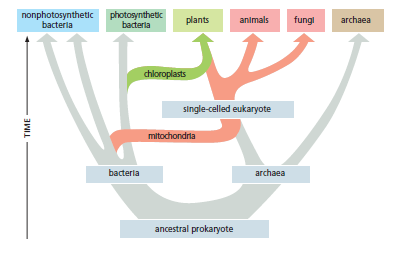Prokaryotic and Eukaryotic cells
Cells are the fundamental units of life. They are small membrane-enclosed units filled with a concentrated aqueous solution of chemicals and endowed with the extraordinary ability to create copies of themselves by growing and dividing in two. Cells come in many different shapes and form but they all have a similar basic chemistry on the inside. they are composed of the same sorts of molecules, which participate in the same types of chemical reactions. In all organisms genetic information in the form of genes is carried in DNA molecules. This information is written in the same chemical code, constructed out of the same chemical building blocks, interpreted by essentially the same chemical machinery and replicated in the same way when a cell or organism reproduces. Thus in every cell, long polymer chains of DNA are made from the same set of four monomers, called nucleotides, strung together in different sequences like the letters of an alphabet. The information encoded in these DNA molecules is transcribed into a related set of polynucleotides called RNA. although some of these RNA molecules have their own regulatory, structural or chemical activities, most are translated into a different type of polymer called a protein. this flow of information is referred to as the central dogma.
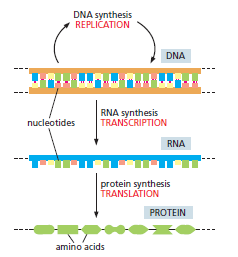
The appearance and behavior of a cell are dictated largely by its protein molecules, which serve as structural supports, chemical catalysts, molecular motors, and much more. Proteins are built from amino acids, and all organisms use the same set of 20 amino acids to make their proteins. But the amino acids are linked in different sequences, giving each type of protein molecule a different three-dimensional shape, or conformation, just as different sequences of letters spell different words. In this way, the same basic biochemical machinery has served to generate the whole gamut of life on Earth.
One of the most commonly cited properties of living things is their ability to reproduce. For cells, the process involves duplicating their genetic material and other components and then dividing in two producing a pair of daughter cells that are themselves capable of undergoing the same cycle of replication. DNA encodes information that ultimately directs the assembly of proteins: the sequence of nucleotides in a molecule of DNA dictates the sequence of amino acids in a protein. Proteins in turn catalyze the replication of DNA and the transcription of RNA into proteins. This feedback loop between proteins and polynucleotides underlies the self-reproducing behaviour of living things.
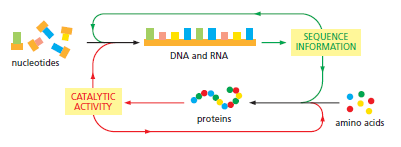
A cell has three main parts: the cell membrane, nucleic acid and the cytoplasm. The first cell was likely formed by enclosure of self replicating RNA into a phospholipid sphere
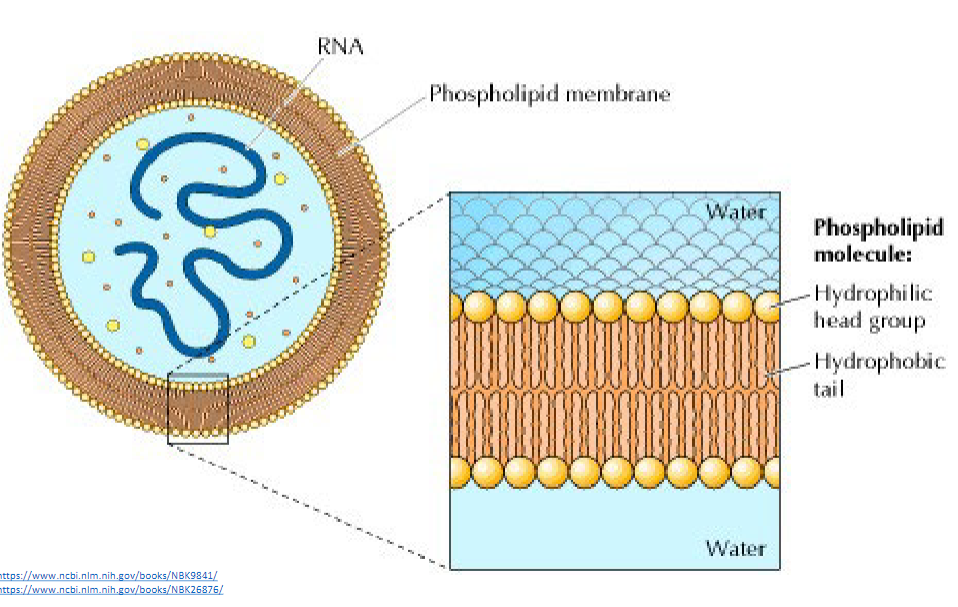
A cell’s genome—that is, the entire sequence of nucleotides in an organism’s DNA—provides a genetic program that instructs a cell how to behave. For the cells of plant and animal embryos, the genome directs the growth and development of an adult organism with hundreds of different cell types. Within an individual plant or animal, these cells can be extraordinarily varied.
Prokaryotic cell
Organisms whose cells do not have a nucleus are called prokaryotes (from pro meaning before and karyon meaning a kernel or nucleus). Prokaryotes are typically spherical, rodlike or corkscrew shaped. They are also small generally just a few micrometers long, although some giant species are as much as 100 times longer than this. Prokaryotes often have a tough protective coat, or cell wall, surrounding the plasma membrane, which encloses a single compartment containing the cytoplasm and the DNA. In the electron microscope, the cell interior typically appears as a matrix of varying texture, without any obvious internal structure. The cells reproduce quickly by dividing in two. Under optimum conditions, when food is plentiful, many prokaryotic cells can duplicate themselves in as little as 20 minutes. In only 11 hours, a single prokaryote can therefore give rise to more than 8 billion progeny (which exceeds the total number of humans currently on Earth). Thanks to their large numbers, rapid proliferation, and ability to exchange bits of genetic material by a process akin to sex, populations of prokaryotic cells can evolve fast, rapidly acquiring the ability to use a new food source or to resist being killed by a new antibiotic.
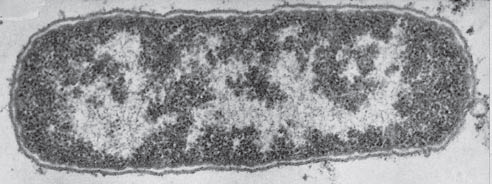
Most prokaryotes live as single celled organisms, although some join together to form chains, clusters, or other organized, multicellular structures. In shape and structure, prokaryotes mat seem simple and limited but in therms of chemistry they are the most diverse class of cells on the planet. They exploit an enormous range of habits, from hot puddles of volcanic mud to the interiors of other living cells, and they vastly outnumber all eukaryotic organisms on Earth. some are aerobic using oxygen to oxidize food molecules, some are strictly anaerobic and are killed by the slightest exposure to oxygen. Mitochondria is said to have evolved from aerobic bacteria that took to living inside the anaerobic ancestors of todays eukaryotic cells. Thus our own oxygen-based metabolism can be regarded as a product of the activities of bacteria cells. Some prokaryotes can live entirely on inorganic substances: they can get their carbon from CO2 in the atmosphere, their nitrogen from atmospheric N2, and their oxygen, hydrogen, suflur and phosphorus from air, water and inorganic minerals. Other living organisms depend on the organic compounds that these cells generate from inorganic materials. Traditionally, all prokaryotes have been classified together in one large group. But molecular studies have determined that there is a gulf within the class of prokaryotes, dividing it into two distinct domains—the bacteria and the archaea—which are thought to have diverged from a common prokaryotic ancestor approximately 3.5 billion years ago. Remarkably, DNA sequencing reveals that, at a molecular level, the members of these two domains differ as much from one another as either does from the eukaryotes. Most of the prokaryotes familiar from everyday life—the species that live in the soil or make us ill—are bacteria. Archaea are found not only in these habitats but also in environments that are too hostile for most other cells: concentrated brine, the hot acid of volcanic springs, the airless depths of marine sediments, the sludge of sewage treatment plants, pools beneath the frozen surface of Antartica, as well as in the acidic, oxygen free environment of a cows stomach, where they break down ingested cellulose and generate methane gas. Many of these environments resmeble the harsh conditions existing in the primitive Earth, where living things first evolved before the atmosphere became rich in oxygen.
Eukaryotic cells
EukaryotIc cells are bigger and more elaborate than bacteria and archaea. Some live independent lives as single celled organisms like amoebae and yeasts. Others live in multicellular assemblies. Complex multicellular organisms like Plants, animals and fungi are formed from eukaryotic cells.
Eukaryotic cells are cells that have a nucleus. Possession of a nucleus goes hand in hand with possession or a variety of other organelles most of which are membrane bound and common to all eukaryotic organisms.
The nucleus is usually the most prominent organelle in a eukaryotic cell. It is enclosed within two concentric membranes that form the nuclear envelope, and it contains molecules of DNA extremely long polymers that encode the genetic information of the organism. These giant DNA molecules become visible in the light microscope as individual chromosomes when they become more compact before a cell divides into two daughter cells. DNA also carries the genetic information in prokaryotic cells; these cells lack a distinct nucleus not because they lack DNA but because they do not keep their DNA inside a nuclear envelope, segregated from the rest of the cell contents.
Mitochondria are present in essentially all eukaryotic cells, and they are among the most conspicuous organelles in the cytoplasm. In a fluorescence microscope, they appear as worm-shaped structures that often form branching networks . When seen with an electron microscope, individual mitochondria are found to be enclosed in two separate membranes, with the inner membrane formed into folds that project into the interior of the organelle. Microscopic examination by itself, however, gives little indication of what mitochondria do. Their function was discovered by breaking open cells and then spinning the soup of cell fragments in a centrifuge; this treatment separates the organelles according to their size and density. Purified mitochondria were then tested to see what chemical processes they could perform. This revealed that mitochondria are generators of chemical energy for the cell. They harness the energy from the oxidation of food molecules, such as sugars, to produce adenosine triphosphate, or ATP—the basic chemical fuel that powers most of the cell’s activities. Because the mitochondrion consumes oxygen and releases CO2 in the course of this activity, the entire process is called cell respiration—essentially, breathing at the level of a cell. Without mitochondria, animals, fungi, and plants would be unable to use oxygen to extract the energy they need from the food molecules that nourish them. Mitochondria contain their own DNA and reproduce by dividing. Because they resemble bacteria in so many ways, they are thjought to derive from bacteria that were engulfed by some ancestor of present day eukaryotic cells. This evidently created a symbiotic relationship in which the host eukaryote and the engulfed bacterium helped each other to survive and reproduce.
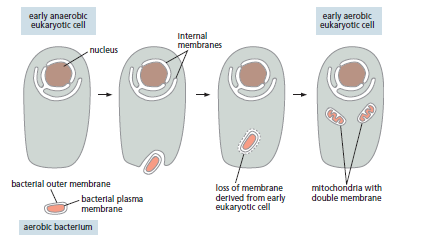
Chloroplasts are large, green organelles that are found in the cells of plants and algae, but not in the cells of animals or fungi. These organelles have an even more complex structure than mitochondria, in addition to their two surrounding membranes, they possess internal stacks of membranes containing the green pigment chlorophyll.
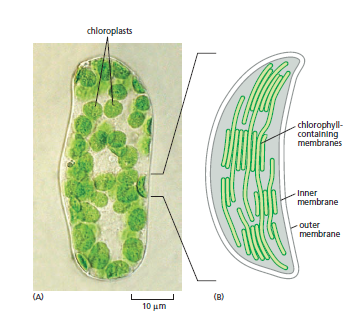
Chloroplasts carry out photosynthesis—trapping the energy of sunlight in their chlorophyll molecules and using this energy to drive the manufacture of energy-rich sugar molecules. In the process, they release oxygen as a molecular by-product. Plant cells can then extract this stored chemical energy when they need it, in the same way that animal cells do: by oxidizing these sugars and their breakdown products, mainly in the mitochondria. Chloroplasts thus enable plants to get their energy directly from sunlight. They also allow plants to produce the food molecules— and the oxygen—that mitochondria use to generate chemical energy in the form of ATP.
Like mitochondria, chloroplasts contain their own DNA, reproduce by dividing in two, and are thought to have evolved from bacteria—in this case, from photosynthetic bacteria that were engulfed by an early aerobic eukaryotic cell.
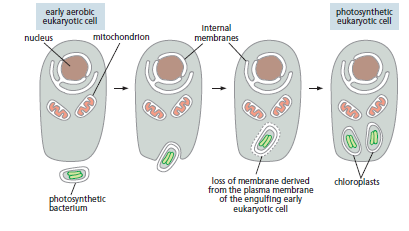
The cytoplasm contains a profusion of other organeles that are surrounded by single membranes. Most of these Structures are involved with the cell’s ability to import raw materials and to export both useful substances and waste products that are produced by the cell. The endoplasmic reticulum (ER) is an irregular maze of interconnected spaces enclosed by a membrane. It is the site where most cell-membrane components, as well as materials destined for export from the cell, are made. This organelle is enormously enlarged in cells that are specialized for the secretion of proteins. Stacks of flattened, membrane-enclosed sacs constitute the Golgi apparatus which modifies and packages molecules made in the ER that are destined to be either secreted from the cell or transported to another cell compartment.
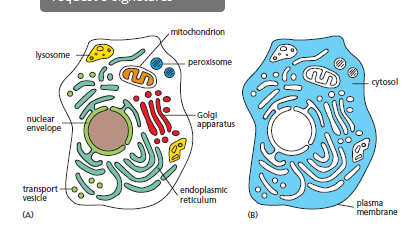
Lysosomes are small, irregularly shaped organelles in which intracellular digestion occurs, releasing nutrients from ingested food particles into the cytosol and breaking down unwanted molecules for either recycling within the cell or excretion from the cell. Indeed, many of the large and small molecules within the cell are constantly being broken down and remade. Peroxisomes are small, membrane-enclosed vesicles that provide a sequestered environment for a variety of reactions in which hydrogen peroxide is used to inactivate toxic molecules. Membranes also form many types of small transport vesicles that ferry materials between one membrane-enclosed organelle and another. A continual exchange of materials take place between the endoplasmic reticulum, the Golgi apparatus, the lysosomes, the plasma membrane, and the outside of the cell. The exchange is mediated by transport vesicles that pinch off from the membrane of one organelle and fuse with another, like tiny soap bubbles that bud from and combine with other bubbles. At the surface of the cell, for example, portions of the plasma membrane tuck inward and pinch off to form vesicles that carry material captured from the external medium into the cell—a process called endocytosis. Animal cells can engulf very large particles, or even entire foreign cells, by endocytosis. In the reverse process, called exocytosis, vesicles from inside the cell fuse with the plasma membrane and release their contents into the external medium; most of the hormones and signal molecules that allow cells to communicate with one another are secreted from cells by exocytosis.
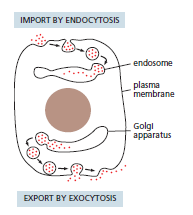
The cytosol is not just a structureless soup of chemicals and organelles. Using an electron microscope, one can see that in eukaryotic cells the cytosol is criss-crossed by long, fine filaments. Frequently, the filaments are seen to be anchored at one end to the plasma membrane or to radiate out from a central site adjacent to the nucleus. This system of protein filaments, called the cytoskeleton, is composed of three major filament types. The thinnest of these filaments are the actin filaments; they are abundant in all eukaryotic cells but occur in especially large numbers inside muscle cells, where they serve as a central part of the machinery responsible for muscle contraction. The thickest filaments in the cytosol are called microtubules, because they have the form of minute hollow tubes; in dividing cells, they become reorganized into a spectacular array that helps pull the duplicated chromosomes apart and dikstribute them equally to the two daughter cells. Intermediate in thickness between actin filaments and microtubules are the intermediate filaments, which serve to strengthen most animal cells.
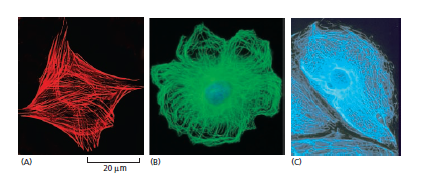
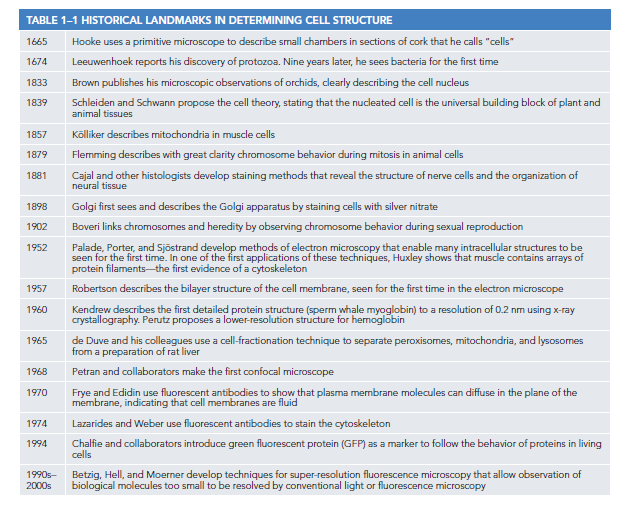

Eukaryotic cells are typically 10 times the length and 1000 times the volume of prokaryotic cells, although there is huge size variation within each category. They also possess a whole collection of features—a nucleus, a versatile cytoskeleton, mitochondria, and other organelles—that set them apart from bacteria and archaea. When and how eukaryotes evolved these systems remains something of a mystery. Although eukaryotes, bacteria, and archaea must have diverged from one another very early in the history of life on Earth, the eukaryotes did not acquire all of their distinctive features at the same time. According to one theory, the ancestral eukaryotic cell was a predator that fed by capturing other cells. Such a way of life requires a large size, a flexible membrane, and a cytoskeleton to help the cell move and eat. The nuclear compartment may have evolved to keep the DNA segregated from this physical and chemical hurly-burly so as to allow more delicate and complex control of the way the cell reads out its genetic information.
Such a primitive eukaryotic cell, with a nucleus and cytoskeleton, was most likely the sort of cell that engulfed the free-living, oxygen-consuming bacteria that were the likely ancestors of the mitochondria. This partnership is thought to have been established 1.5 billion years ago, when the Earth’s atmosphere first became rich in oxygen. A subset of these cells later acquired chloroplasts by engulfing photosynthetic bacteria.
